Fishing for New Ways to Sustain Aquatic Habitats

January 2006
Dr Jeremy Hindell
Department of Primary Industries, PO Box 114, Queenscliff, VIC 3225
Email: Jeremy.hindell@dpi.vic.gov.au, Ph: 03 5258 0231
Table of Contents
Executive Summary
Introduction
Methods
Placement of acoustic receivers
Catching and tagging Acanthopagrus butcheri
Results and Discussion
Conclusions
Acknowledgements
References
Appendix 1
List of articles published in newspapers.
Hand-out used to inform public of project (posted in shops and distributed to interested people).
Executive Summary
Large woody debris (LWD) is a conspicuous habitat in estuarine systems worldwide. LWD is thought to provideshelter, feeding and breeding habitat for species of fish that contribute to recreational and commercial fisheries. Much of the LWD in Australia's estuaries has been removed to improve the navigability of waterways and reduce the likelihood of flooding. With increased understanding of the importance of LWD in the ecological functioning of estuarine systems, programs have recently been initiated to reinstate LWD.
To date, there has been little assessment of the use of artificial structures by estuarine fauna, particularly fish. This project used acoustic tagging methods to assess whether the movements and residency times of adult black bream (Sparidae, Acanthopagrus butcheri) varied among regions of estuaries with and without re-introduced LWD in the Gippsland Lakes, Victoria.
In each of two estuarine systems, acoustic receivers were strategically placed at a site with LWD, as well as at sites up- and downstream. Adult black bream (n = 25) were implanted with coded acoustic transmitters in December 2004, and fish were monitored for the next 12 months. Patterns of use by fish varied inconsistently among sites with- and without LWD through time (months) and between rivers (Tambo, Mitchell). In the Mitchell River, the average number of visits, hits and time were greater at sites with LWD than at those without, but in the Tambo River there was no difference between sites with and without LWD (pooling across all months). Movement patterns changed significantly among months, with fish using areas with LWD more at some times of the years than others.
The re-establishment of LWD in estuarine systems can influence the movement and residency times of diadromous fish such as black bream. Acoustic telemetry is a valuable tool in assessing the use by fish of artificial structures.
Introduction
The recreational and commercial fisheries for black bream in the Gippsland Lakes (eastern Victoria) are considered to be among the most important scale-fish fisheries in Victoria. The recreational fishery for black bream is thought to be particularly important in supporting local industries, including tourism. Over the past 2 years, however, catches of black bream in the Gippsland Lakes have decreased. The reasons for the stock decline are unknown, but are thought to be related to habitat and environmental degradation and subsequent reductions in reproduction and survival.
An obstacle to understanding the fishery decline is that we know very little about which habitats are most important to black bream, and how habitat preferences change through time. If we can identify the most important habitats (or areas of estuaries), we can better predict how changes to these habitats, due to flooding, habitat destruction or pollution, may influence local abundances of black bream. Increased understanding of fine-scale movement patterns can be used to identify which habitats are important to protect, and improve habitat restoration projects such as those involving the re-introduction of large woody debris (LWD).
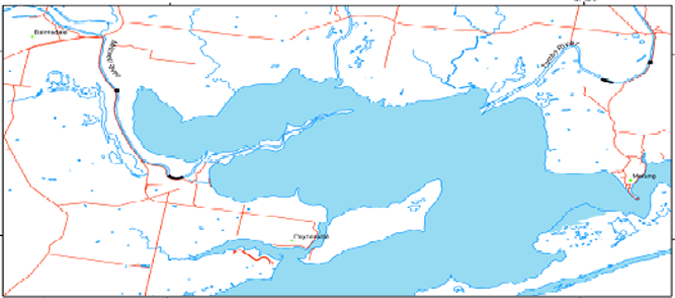
Overview Map
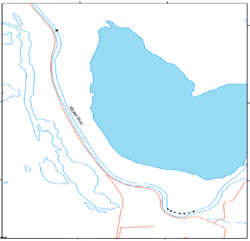
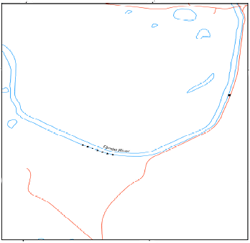
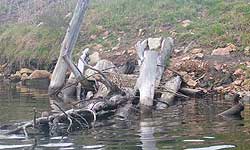
The East Gippsland Catchment Management Authority (eastern Victoria) recently initiated a program to re-introduce LWD at a single location (site) in each of the Tambo and Mitchell rivers (which flow into the Gippsland Lakes, Figure 1). Each LWD structure is constructed from large logs tied together with steel cable, dropped into the water, and firmly attached to the bank to prevent them being washed away during floods (Figure 2). There are six structures at each site, with each structure separated by approximately 100m. The primary purpose of this program was to increase the available habitat. Increased structure is thought to provide fish with protection from predators and/or disturbance and provide greater levels of food, thereby benefiting the fisheries. Until this project, however, there had not been any assessment of the success or otherwise of these structures in delivering benefits to the local recreational fisheries for species such as black bream.
This project had four primary objectives:
- Track the fine-scale habitat associations of black bream in the Gippsland Lakes to determine when and for how long fish use artificial versus natural structure,
- Identify whether patterns of habitat use change with local environmental conditions,
- Provide information on the movement and habitat preferences of black bream that can be used to sustainably manage stocks of this species and 'critical' habitats on which they depend, and
- Facilitate community involvement in research for the management of valuable fisheries.
Methods
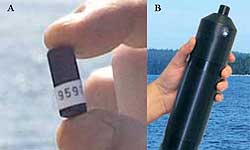
The movements of black bream in our study system were monitored using acoustic telemetry. Acoustic telemetry has been used with great success in identifying patterns of movement in snapper, sharks and estuary perch in southern Australia (Heupel et al. 2006), and the technique is suitable in tracking the finescale movements of black bream. Acoustic receivers and transmitters produced by VEMCO were used. The transmitters (V8C, Figure 3a) emit coded ultrasonic (69kHz) transmissions at random intervals between 30 and 60 seconds. The receivers (V2R, Figure 3b) can detect these ultrasonic transmissions, enabling particular fish to be identified and the time particular fish spent around a receiver to be recorded.
Placement of acoustic receivers
Acoustic receivers were set-up at strategically chosen locations in each of the Mitchell and Tambo Rivers, both at the sites with LWD and at sites up- and downstream (Figure 4).
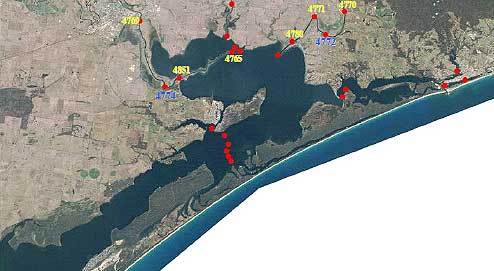
Fig 4. Sites at which acoustic receivers were placed in the Tambo and Mitchell River (shown by red dots with receiver IDs). Note, receiver numbers in blue correspond with LWD.
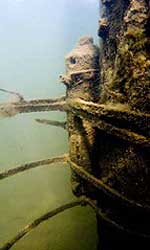
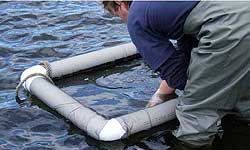
Catching and tagging black bream
The methods for tagging and tracking fish using acoustic telemetry have been refined by DPI staff assessing habitat preferences of estuary perch.
Black bream were caught using both recreational (line and hook – only lip-hooked fish) and commercial (seine net) methods to reduce any potential for method of capture to influence the results. The Nicholson Angling Club caught fish recreationally, while Barry (Doc) McKenzie and Rob Jenkins assisted with the commercial fishing. Captured fish were held in darkened 50cm square nets (with 6mm mesh) before being tagged to reduce stress (Figure 6).
Prior to starting the surgery, all equipment was washed with fungicide. Fish were anaesthetised in benzocaine. Once unconscious, the length (fork length, mm) and weight (g) of each fish was measured. The fish was then placed upside down in a cradle, with a moist cloth placed over the head. Several scales (two lines of five) were removed from a region of the fishes belly just dorsal and anterior to the anus (Figure 7).
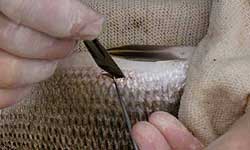
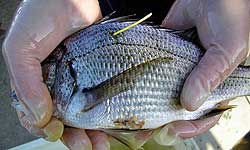
A small incision (approx 10 mm long) was made where the scales had been removed (Figure 7), allowing access to the peritoneal cavity in a region ventral to the gonads. Acoustic transmitters were implanted into 25 adult/juvenile black bream.
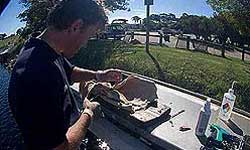
The tagged fish ranged in size 195 - 324 mm (fork length – FL, ). All fish were tagged outside the rivers with LWD (i.e. Mitchell and Tambo rivers) so that movements of fish could better be interpreted with respect to movements and habitat use rather than established patterns of residency.
| Date | Length (mm) |
Weight (g) | Release location |
Method of capture |
External tag | Transmitter | Transmitter serial no. |
|---|---|---|---|---|---|---|---|
| December-04 | 212 | 225 | Jones Bay | Seine | TRO 4594 | 6181F | 1201 |
| December-04 | 203 | 173 | Nicholson | Angling | TRO 4576 | 6182F | 1202 |
| December-04 | 205 | 195 | Jones Bay | Seine | TRO 4585 | 6183F | 1202 |
| December-04 | 247 | 340 | Jones Bay | Seine | TRO 4593 | 6184F | 1204 |
| December-04 | 243 | 309 | Nicholson | Angling | TRO 4568 | 6185F | 1205 |
| December-04 | 324 | 740 | Nicholson | Angling | TRO 4574 | 6186F | 1206 |
| December-04 | 227 | 257 | Nicholson | Angling | TRO 4567 | 6187F | 1207 |
| December-04 | 213 | 208 | Nicholson | Angling | TRO 4573 | 6188F | 1208 |
| December-04 | 215 | 230 | Jones Bay | Seine | TRO 4583 | 6189F | 1209 |
| December-04 | 197 | 185 | Jones Bay | Seine | TRO 4591 | 6190F | 1210 |
| December-04 | 309 | 668 | Nicholson | Angling | TRO 4569 | 6191F | 1211 |
| December-04 | 216 | 225 | Jones Bay | Seine | TRO 4592 | 6192F | 1212 |
| December-04 | 225 | 244 | Nicholson | Angling | TRO 4580 | 6197F | 1217 |
| December-04 | 214 | 225 | Jones Bay | Seine | TRO 4589 | 6198F | 1218 |
| December-04 | 213 | 210 | Jones Bay | Seine | TRO 4584 | 6229F | 1249 |
| December-04 | 195 | 165 | Jones Bay | Seine | TRO 4586 | 6230F | 1250 |
| December-04 | 211 | 192 | Nicholson | Angling | TRO 4577 | 6843F | 1251 |
| December-04 | 215 | 216 | Nicholson | Angling | TRO 4570 | 6844F | 1252 |
| December-04 | 210 | 200 | Jones Bay | Seine | TRO 4596 | 6846F | 1254 |
| December-04 | 225 | 241 | Nicholson | Angling | TRO 4579 | 6847F | 1255 |
| December-04 | 203 | 183 | Nicholson | Angling | TRO 4572 | 6848F | 1256 |
| December-04 | 218 | 225 | Jones Bay | Seine | TRO 4595 | 6848F | 1257 |
| December-04 | 203 | 185 | Jones Bay | Seine | TRO 4587 | 6850F | 1258 |
| December-04 | 217 | 210 | Nicholson | Angling | TRO 4578 | 6850F | 1259 |
| December-04 | 224 | 241 | Nicholson | Angling | TRO 4571 | 6852F | 1260 |
Table 1. Length, weight, release location, capture method and tag information of all fish tagged.
Results and Discussion
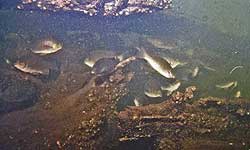
Opportunistic underwater observations of the LWD while installing listening stations demonstrated that the LWD were used by a variety of fish, including black bream, luderick (see Figure 10) and several species of goby.
Twenty-five fish were tagged in December 2004. The patterns of use by black bream of sites with and without LWD varied with the time of year (month) and the river (Tambo, Mitchell, Figures 11 to 14). Regardless of the time of year (data pooled across months), in the Mitchell River the number of visits, number of hits (receiver detections) and amount of time (seconds) spent in the vicinity of a listening station were all significantly higher at sites with LWD than at some of the other sites upstream (upper), downstream (lower) or close by (middle)(Figure 11). Conversely, visits, hits and time were similar among areas, regardless of their location along the river or the presence of LWD in the Tambo River (Figure 12).
Patterns of movement and use of sites with LWD varied strongly with the time of year (month). For both rivers, bream used sites with LWD more than those without artificial structure during some months, but used sites up- and downstream more than those with the LWD in others (Figures 13 & 14).
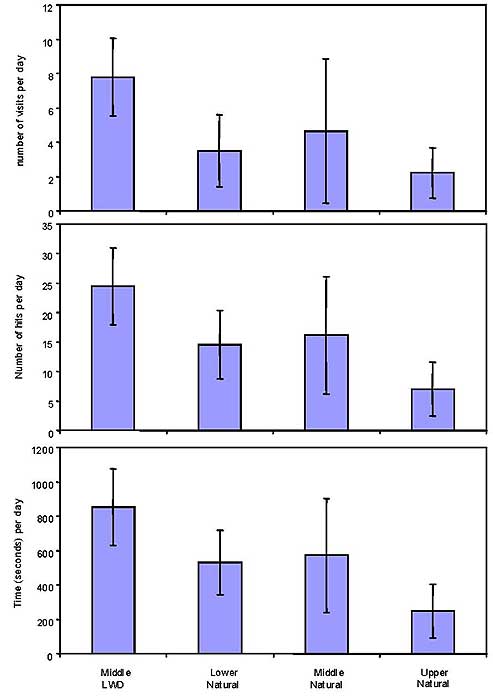
Fig 11. Mean (± se) number of visits, number of hits and time spent in the vicinity of a listening station at each of the sites along the Mitchell River.

Fig 12. Mean (± se) number of visits, number of hits and time spent in the vicinity of a listening station at each of the sites along the Tambo River.
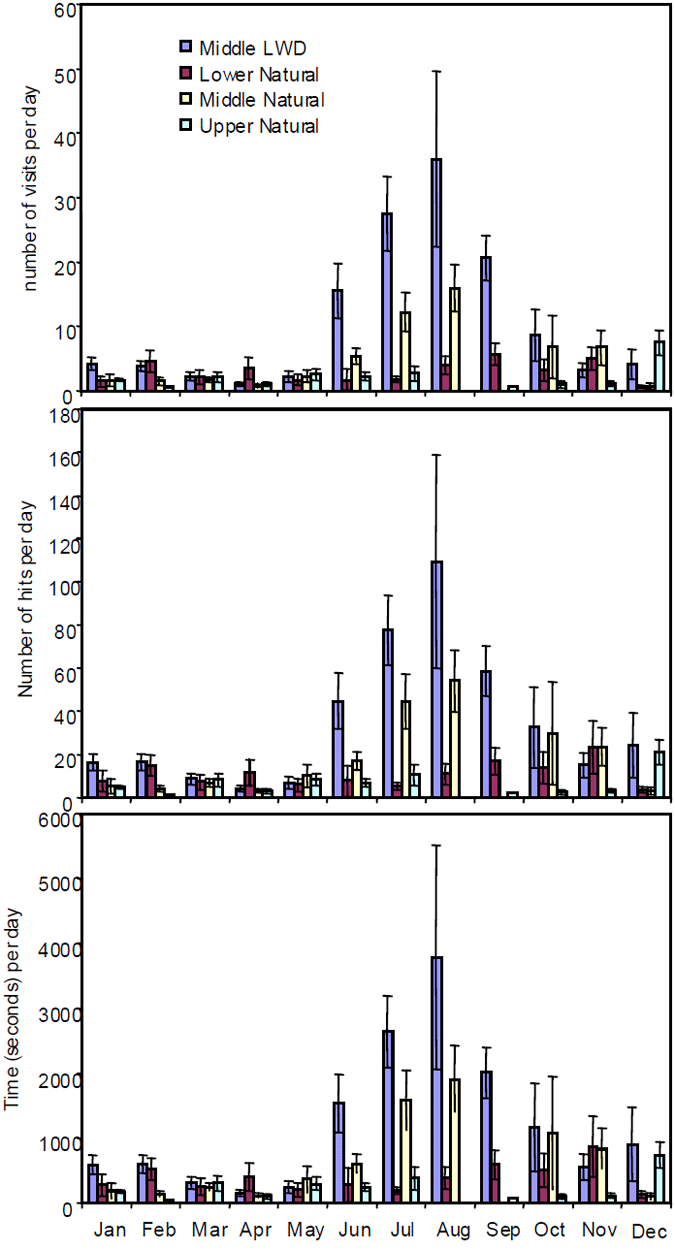
Fig 13. Mean (± se) number of visits, number of hits and time spent in the vicinity of a listening station at each of the sites along the Mitchell River, by month.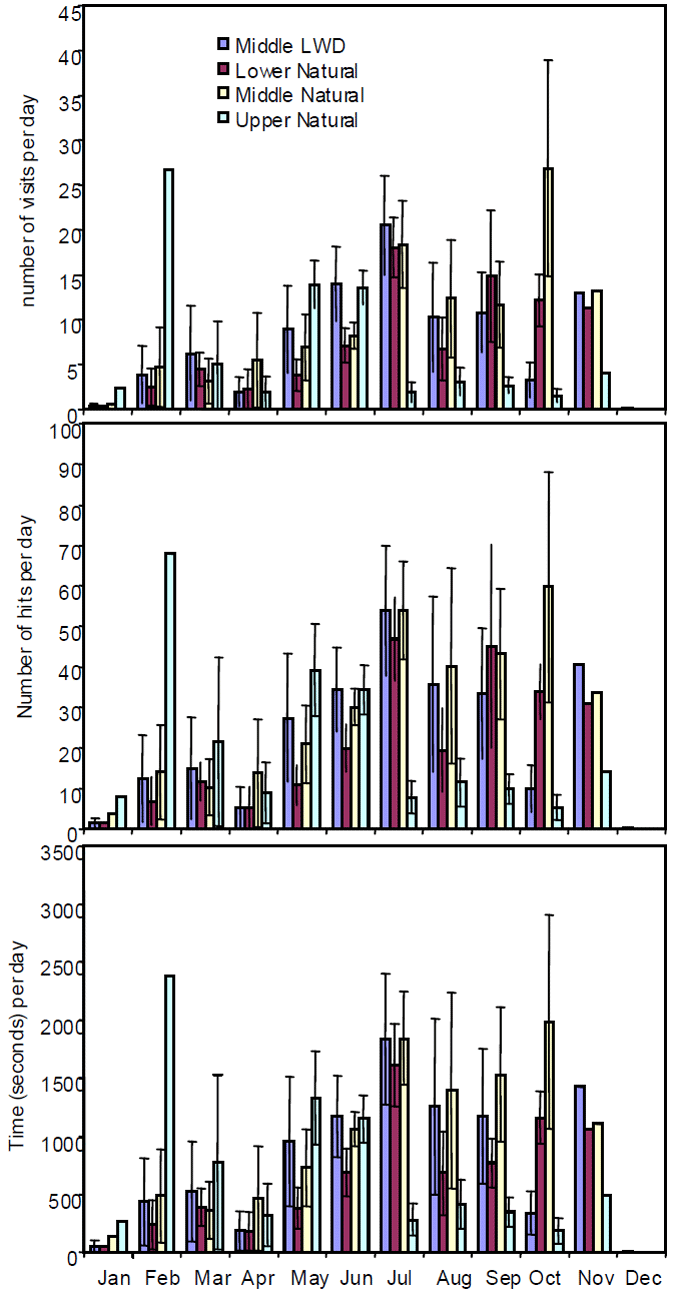
Fig 14. Mean (± se) number of visits, number of hits and time spent in the vicinity of a listening station at each of the sites along the Tambo River, by month.
There was low mortality of fish in the study. Of the 25 fish tagged, all fish were detected for at least a period of 2 months (to the end of January 2005), and 21 of the fish to the end of November 2005. Despite the manufacturers suggesting a tag life of 240 days (based on the frequency and power of transmissions – VEMCO guidelines), many of the fish in the study were being detected in November, more than 300 days after implanting.
Acoustic telemetry is among the most powerful tools in assessing the movements of fish. It has been particularly useful in elucidating spatial affinities, with, for example, marine parks and different types of habitat. This study showed that acoustic telemetry can also be a useful tool in assessing the use by fish of artificial structures used in the remediation of estuarine habitats.
This work suggests that fish may visit areas with artificial structure more than areas without, although this depends on the river system and the time of year. The reasons why fish associate with the LWD could include enhanced protection from predators (such as birds), greater levels of food or better feeding opportunities (e.g. improved ability to ambush prey from behind structures), or relief from other environmental perturbations (such as high flows).
In adding artificial structure to a system there is an assumption that it will actually benefit the target species (in this case a recreational fisheries species). This is not always the case. Studies in open-water marine systems have shown that fish aggregate around floating objects, making them easier to catch. If the reason for adding structure to a system was to increase fisheries productivity, it would be somewhat circular if the structures simply aggregated fish and made them easier to catch. This was not the case in the present study. While black bream sometimes used the LWD more than areas without these structures, they did not live around these structures for extended periods of time. Instead, fish moved up and down the estuarine systems, with the LWD perhaps providing a refuge during their travels.
The positive association of black bream with LWD does not necessarily mean that these structures per se are used more by fish. A drawback in the current experimental design was that we had no data on fish movements prior to the LWD being added to the system. This means that any patterns associated with the LWD could simply be related to the area of the river within which they were put. Our design enabled us to compare areas up- and down-stream, as well as an area close by with similar channel morphology and natural habitat availability, and in this way provided some evidence to suggest that the patterns observed were not simply due to fish responding to a unique habitat type or set of conditions coincidental with the placement of LWD. Nonetheless, future studies should attempt to collect data before the artificial structures are placed in the system. Given the great variability in fish-habitat (site) associations through time, we further suggest that this data should be collected over temporal scales of months and in alternative river systems.
Conclusions
The use of acoustic telemetry to monitor the movements of fish has shown great potential around the world. This is the first time black bream have been tagged in Australia, and the results suggest that acoustic tagging studies on this species offer great potential in deciphering their patterns of movement, particularly in estuarine systems, and especially in relation to specific habitat types. The fish appeared to recover well from the surgery (very low mortality) and, while it is impossible to say that the movements of fish were not affected by the tags (and the surgery), survival and large scale movements suggest they were not. While this project will continue to run for at least another 12 months (contingent upon additional funding), there have been two primary outcomes from this work.
First, the results from the study indicate that acoustic telemetry is a useful method of assessing broad-scale fish-habitat affinities. This technique will be useful in the future assessment of the importance (or otherwise) of adding artificial structure to Victoria's rivers and estuaries. Second, the results from this work suggest that LWD is used by black bream, and, while preliminary, the findings provide a starting point for determining how the structure, placement and timing of artificial habitat in Victoria's rivers and estuaries influences fisheries productivity.
The addition of LWD to estuarine systems with little natural woody structure appears to provide temporary habitat for fish moving up and down the system, although future work should attempt to collect data before any structures are put in the system to separate spatial (site) effects from treatment (addition of LWD) effects. This work was a resounding success in engaging the recreational fishing community and generating interest in the media and at all levels of Government (see Appendix 1). A presentation at the Fishcare Conference (Lakes Entrance, August 2005) was warmly received and generated enormous interest in finding out more< about how and why fish move. The Nicholson Angling Club, in particular, were most generous with their time, and this project led to the development of additional research applications to further investigate bream (Australian Research Council Grant application to investigate the links between bream and freshwater flows) and other species (e.g. dusky flathead proposal to the FRAC). This type of research provided an important avenue for recreational fishers to get involved with the research that ultimately helps to manage fish stocks, and thereby instilled in fishers a greater sense of ownership of their resources and how they are best managed.
Acknowledgements
This project would not have been possible without generous funding from Recreational Fishing Licence revenue. Land and Water Australia and the East Gippsland Catchment Management Authority also provided significant financial assistance. The Nicholson Angling Club and Barry (Doc) McKenzie were outstanding contributors to this project, not only in catching fish, but in helping with fish tagging and monitoring listening stations.
Appendix 1
Fish,chip and radios part of science award. Article published in the Bairnsdale Advertiser (11/10/2004).
Fires fail to singe trout. Article published in the Weekly Times (01/12/2004)
Woody Debris added. Article published in the Lakes Post (Front Page, 05/10/2005).
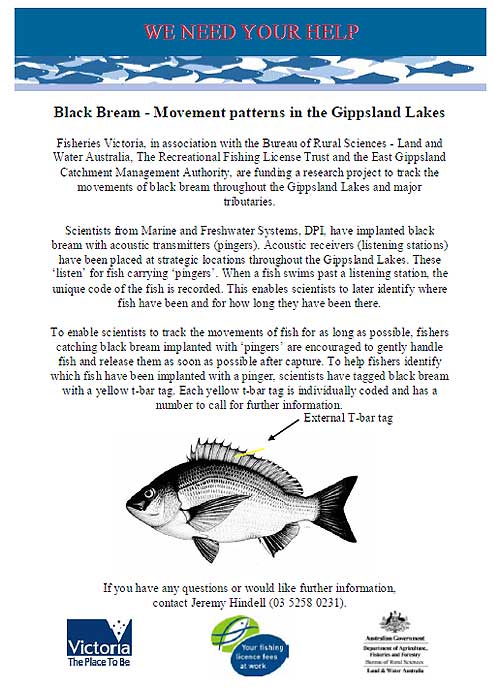
Handout used to inform public of project (posted in shops and distributed to interested people)
